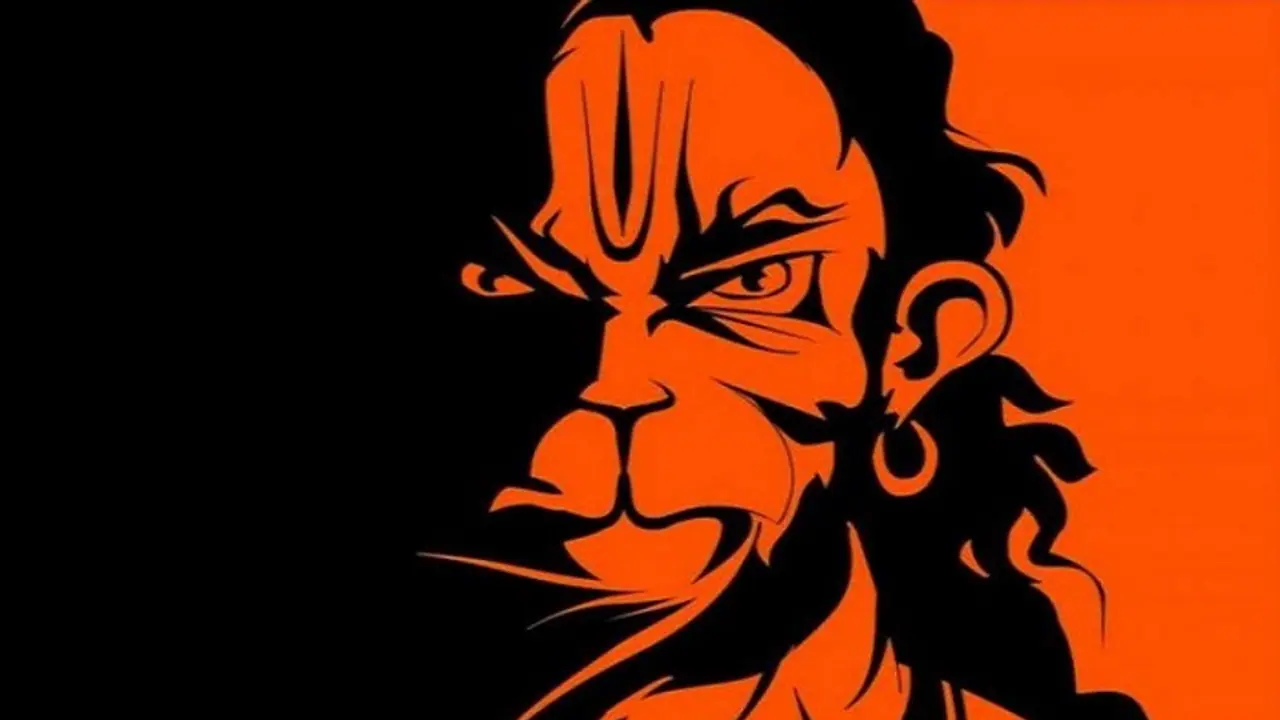Hindus continue to be shamed and humiliated as intolerant oppressors, when they are usually the victims. The courts regulate Hindu practices, while not interfering with those of other religions. Hindu temples are run by State governments, with non-Hindus or anti-Hindus on their temple boards, and temple revenues expropriated by the state for whatever purpose the state deems fit...
Hanuman certainly has a right to be assertive today. After 70 years of Independence, the forces of adharma are still powerful in India, seeking to hold down, divide and disrupt the country.
Some people are asking: Why is Hanuman angry, as he appears to be today in depictions throughout India? Isn’t Hanuman the embodiment of devotion and selfless service, a force of love? Isn’t Hanuman a great yogi replete with self-control on all levels? Is this harsh depiction perhaps more a reflection of the aggression of the people following him today and their Hindutva sentiments?
Yet, if we look at the story of Hanuman, he is first and foremost a great warrior who has inspired warriors and armies throughout history, particularly those who defended India from invaders and protected its temples from destruction. Yet unlike Arjuna in the Bhagavad Gita, Hanuman went through no dejection on the battlefield; he was always ready to fight with full dedication.
Also read: Guru Purnima: Should we make opinionated media or self-serving netas our new gurus?
Hanuman was the leader, the general of the divine army of Sri Rama. He had to perform numerous harsh actions from the burning of the city of Lanka to the great battle with Ravana’s demon hordes. Hanuman was an indomitable warrior who fought without pity, compromise or apologies, yet also without malice or hatred. Hanuman has long been revered as both an ideal warrior and ideal yogi, each complementing the other.
Hanuman was the son of Vayu, the cosmic god of wind, who represents the electrical or lightning forces of nature that pervade all space and are the source of all energies in the universe. That is why Hanuman can fly through the air or become as large or as small as he wishes.
Looking back to the story of the Mahabharata, Krishna and Arjuna had the figure of Hanuman on their chariot’s insignia to inspire them. Bhima, the fiercest warrior among the Pandavas who killed Duryodhana to avenge Draupadi’s public humiliation, was regarded as a manifestation of Hanuman from whom he gained his powers.
Hanuman himself was a manifestation of Lord Shiva, particularly in his tempestuous Rudra form to destroy all negativity. Shiva himself is Bhairava, meaning he who is fierce and Vayu is one of Shiva’s forms. Hanuman represents awesome power and is not merely a playful image or poetic metaphor, which is not to fear but to appreciate and honour his stature.
Hanuman certainly has a right to be assertive today. After seventy years of independence, the forces of adharma are still powerful in India, seeking to hold down, divide and disrupt the country. There is no Ram temple at Ayodhya, the most sacred of ancient India’s seven sacred cities, from which Ram Rajya as the rule of Dharma used to emanate throughout the country.
Also read: Baba Ramdev and India’s yoga gurus face biased attacks from Western media
Hindus continue to be shamed and humiliated as intolerant oppressors, when they are usually the victims. They have been told not to speak out, even for their own rights, because they don’t have a legitimate voice in social affairs and will be guilty of an intolerant majoritarianism if they do. The courts regulate Hindu practices, while not interfering with those of other religions. Hindu temples are run by State governments, with non-Hindus or anti-Hindus on their temple boards, and temple revenues expropriated by the state for whatever purpose the state deems fit. Hindu educational institutions face severe restrictions and cannot teach what they want, unlike non-Hindu groups. Above all, Hindus have been told not to be political, not to vote as a group as that is communal, yet by political parties that have long promoted other religious vote banks against the Hindus.
Communists dominate Kerala, the land of the Vedas, and are trying to eliminate its ancient dharmic heritage, calling Vamana a myth. The government of Bengal can’t even use the term Ramdhanu or Rama’s bow in its Bengali language for fear of offending minorities. While some Congress party leaders now claim to be Hindus, they divide Karnataka Shaivites into Hindus and non-Hindus, and conspire to prevent the Ayodhya case from being resolved.
Yet, even beyond India, the Earth is suffering from ecological dangers of many types, with traditional and indigenous cultures, along with plant and animal ecosystems under siege everywhere. Hanuman as protecting Mother Sita, who is connected to Mother Earth, cannot be happy about that either.
Yes, Hanuman has always had a fierce warrior form, which has defined his primary role in dedication to Sri Rama. Hanuman has his soft and gentle form as well for his devotees, but not for Rama’s enemies.
Such a fierce Hanuman is the face of a new dharmic awakening that must be acknowledged, and cannot simply be denigrated as Hindu communalism or Hindutva prejudice.
Hanuman is rising again. Jai Hanuman! Jai Sitaram!
